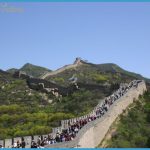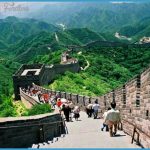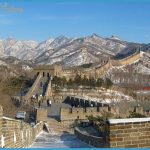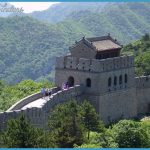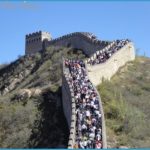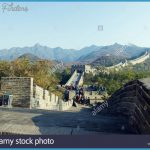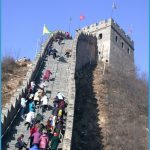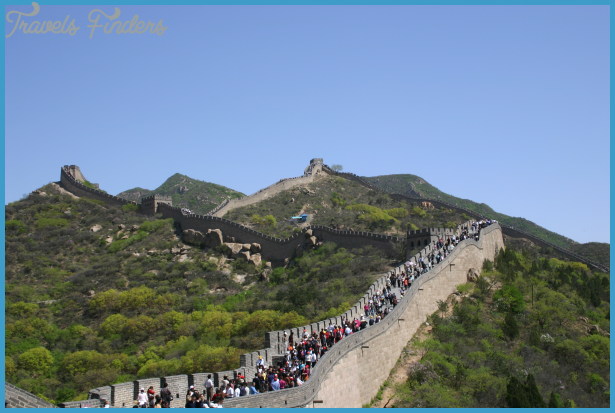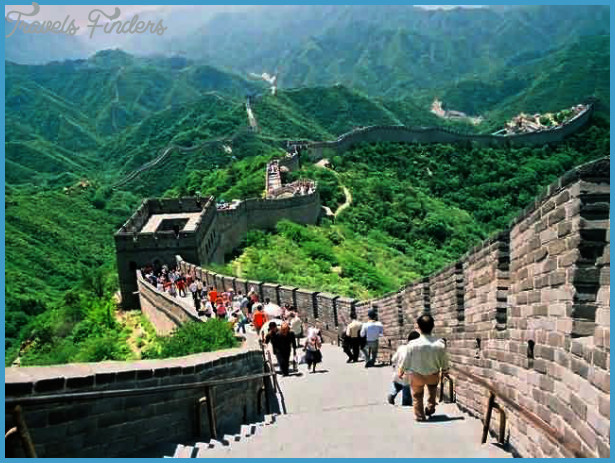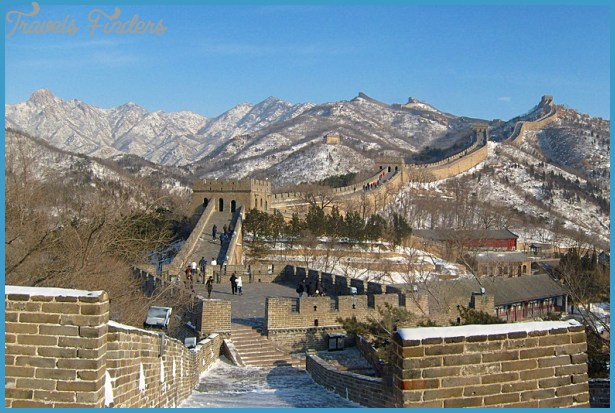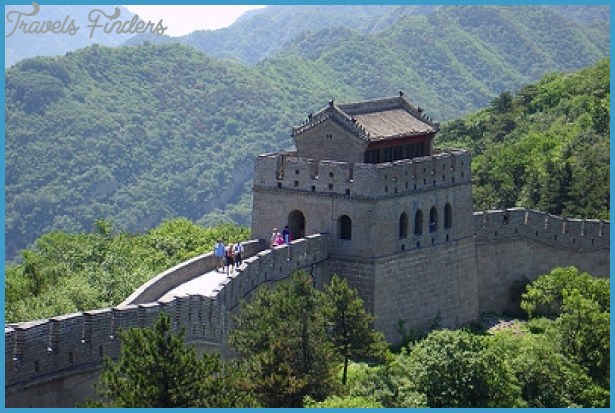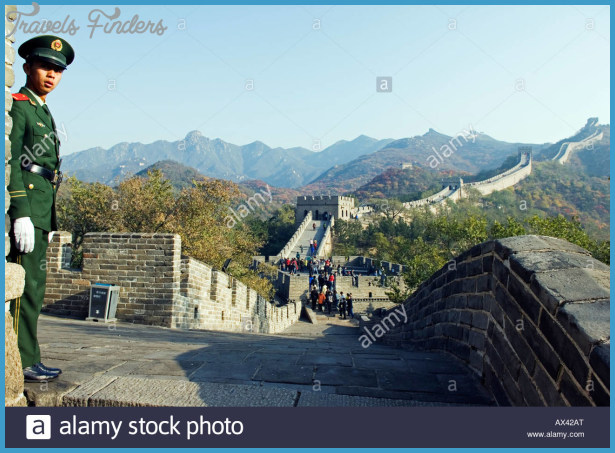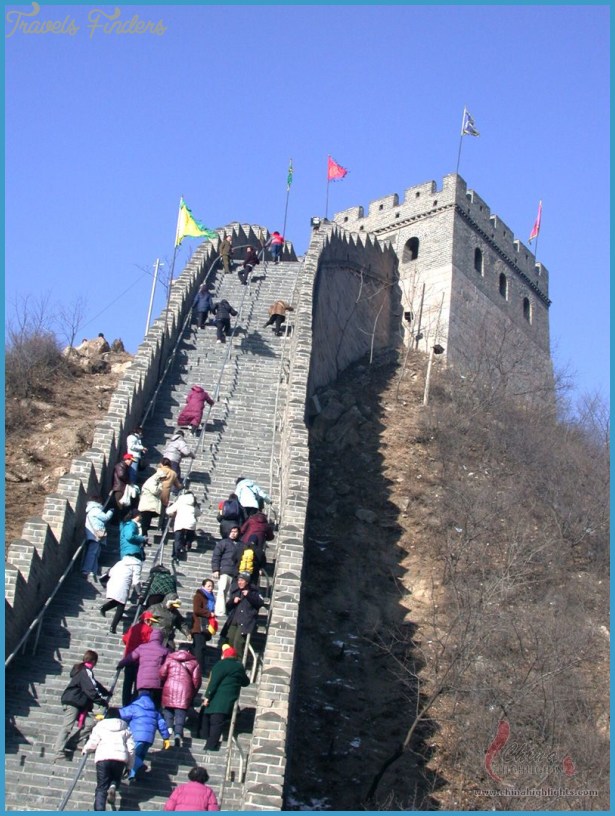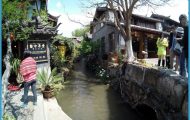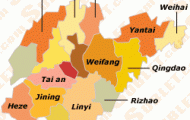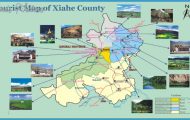The tomb site, measuring about 40sq.km/25sq. miles lies in a valley of the Tianshoushan hill, almost 50km/31 miles to the north of Beijing. It is the “monumental graveyard” ofthe Ming dynasty, where thirteen ofthe sixteen dynasty’s emperors are interred, together with empresses and concubines. In accordance with an old tradition, the rulers had their tombs built during their lifetime. Hence Emperor Yongle (reigned 1402-24) arranged for his tomb site to be decided upon and measured. When choosing the site soothsayers were brought in to arrange, in particular, protection from the wind and against the bad spirits coming from the north. The valley of Tianshoushan was ideal for this purpose, as it is not exposed on the west, north and east sides. Peasants living in the vicinity were forced to leave. This graveyard was used for over two hundred years (1409-1644). During this time the whole area was protected by a surrounding wall and imperial
guards. All visitors including the emperor were only allowed to enter the area on foot. A large number of labourers maintained the site.
Each funeral site has, in addition to the actual burial hill, its own sacrificial hall and stele pavilion. Until now only the Changling and Dingling tombs have been restored.
Path of Souls The Path of Souls, leading to the imperial necropolis of Changling, can be(Shen Dao) reached through the marble Gate of Honour (Shi Paifang; erected 1540).
Along the path the visitor comes upon the Great Red Gate (Dagong Den), the passage through which had doors to secure it, the middle door being only opened for the ceremonies of imperial burials. Next is the Pavilion of the Great Stele (Dabei Lou), with a 6.5m/21ft high marble stele rising from the back of a statue of a tortoise (1426). Connected to this is the Avenue of Stone Statues (1435), lined with twelve pairs of animals and six pairs of humans.
At the end of the avenue is the Dragon and Phoenix Gate (Longfeng Men) with two arches. We then pass by the Shisanling Reservoir, (constructed in the 1950s).
Changling Tomb Further north is the Changling (open: 9am-5pm), the tomb of the third Ming Emperor Yongle (reigned: 1402-24) and Empress Xu, who died in 1407. The tomb is surrounded by a magnificent wall.
A red gate with three arches leads to the first courtyard with a stele pavilion ofthe Qing dynasty (1644-1911) and the Gate of Mercy (Ling’en Men) In the second courtyard is the Hall of Mercy (Ling’en Dian) with 32 sandalwood columns rising from a three-tiered terrace. In the third courtyard is a stele pavilion standing on a square based tower. The stele inside bears the inscription “Tomb ofthe Emperor Chengzu” (the name given to Yongle after his death). In front of the tower is an altar on which marble ritual vessels have been placed.
The Dingling tomb was erected for Emperor Wanli (reigned: 1572-1620) and his two wives – Xiaoduan (died 1620) and Xiaojing (died 1612), who was only laid to rest here after her son succeeded to the throne and raised her status to that of emperor’s widow. The building of the tomb on the orders of Wanli was begun in 1584 and took six years to complete. The excavations, carried out in May 1956 disclosed an “underground palace” consisting entirely of white marble. The tomb, of very similar structure to the Changling tomb, is the only one to be opened so far.
In the first two courtyards there remain only the terraces on which halls once stood. In the diamond wall surrounding the tomb mound is a gate which leads underground to a 1195sq.m/1429sq.yd site complex consisting of five rooms. The middle room houses three marble thrones, several altars and a large blue and white porcelain vessel containing oil, which apparently serves as an “eternal light”. The tomb-chamber is the last and largest of these three rooms; this is where the emperor’s coffin is kept; the empress lies to the left of the emperor and his concubine to his right.
The Gouya rocks are three steeply rising peaks, the highest of them at 1500m/1641ft. They are situated 10km/6 miles to the north-west ofthe Ming tombs. The majority of the 72 temples which were established in this area between the 14th and the 19th c. have unfortunately been destroyed. The area still attracts many tourists because of its natural beauty- narrow paths winding through rocks and shrubs, mountain springs, rare birds and many other attractive features.
The Grotto of Clouds and Waters, richly endowed with stalagmites and stalactites, is hidden on the slopes of the Shangfangshan about 50km/31 miles to the south-west of Beijing. The well-lit grotto has been open to the public since 1980.
The Temple where the Clouds Dwell consists of five courtyards with six main halls and numerous other buildings. It is situated 75km/46 miles to the south-west of Beijing. The buildings were originally constructed over 1300 years ago, but they were destroyed during the war in the 1930s and 40s, since when they have been rebuilt. In the nine grottoes to the north-east of the temple are 4195 stone tablets dating from the 7th c. to the 17th c. They are inscribed with Buddhist inscriptions. A further 10,000 tablets, also with Buddhist inscriptions, were buried in the 12th c. to the south of the temple. The 30m/98ft high pagoda to the north of this site also dates from before the 12th c.; the four smaller dagobas nearby were constructed during the Tang period (618-907).
15km/9% miles to the west of the temple is one of the mooring places situated on the upper reaches of the River Juma. This area is known for its picturesque valleys and unusual rock formations; its beauty is often compared to that of Guilin.
In the region of Zunhua, a small city about 100km/62 miles to the east of Beijing, is an area over 125km/78 miles wide and 20km/12 miles long forming the eastern Qing necropolis. In the fourteen tombs lie five Qing emperors (1644-1911), fifteen empresses, 136 concubines and five princesses. The building of this monumental graveyard began in 1663 and took several years to complete. The mausoleums here are built underground like the ones in the Ming Necropolis, and in front of every tomb stand several memorial buildings.
Yuling is the tomb of Emperor Qianlong (reigned: 1735-96). On the walls of the “underground palace” with its four decorative gates, are Buddha reliefs with inscriptions in Sanskrit and Tibetan.
Cixi Tomb From an architectural point of view the Cixi tomb is the most splendid. It is situated about 1km PA mile to the west ofthe Yuling tomb. The decorative patterning on the ceiling, beams and columns in the hall is completely covered with gold-leaf.
Worth seeing is the high-relief on the enormous stone tablet which takes up the whole middle section of the steps leading up to the main hall of the mausoleum; at the top is a portrayal of a phoenix to symbolise the empress, and at the bottom is a dragon to symbolise the emperor. This representation suggests that the empress is of far greater importance than any emperor.
Western Qing The western Qing necropolis, almost 500,000sq.m/598,OOOsq.yd in size and members of the family including wives, concubines, sons and daughters. The reason for laying out of two dynastic tomb sites was that the emperor Qianlong made a law which meant that fathers and sons could not be buried in the same graveyard.
Tombs thus smaller than the eastern necropolis, lies 120km/74 miles to the south(Qing Xi Ling) west 0f Beijing. Buried in the fourteen tombs are four emperors, and 72
Mausoleums The fourteen mausoleums and the temple buildings belonging to them reflect the strict rules of the feudal hierarchy. The tombs of the emperors and empresses are larger than those ofthe concubines and princesses; the former have red roofs and the latter have green roofs.

